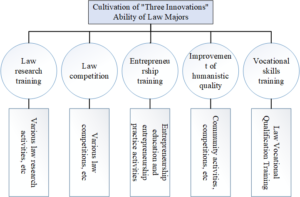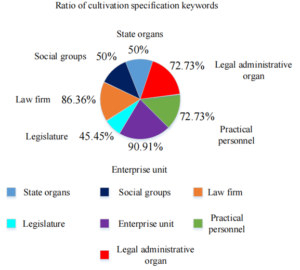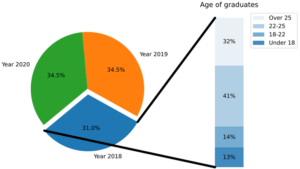Digital services, including healthcare, among others, have recently seen a massive volume of complicated data that arrives rapidly due to a rapid increase in the number of smart devices, focusing on the needs of regional emerging economic development and industrial structure adjustment, this paper explores the dynamic adjustment of a major in which schools, governments, enterprises and international cooperation participate in the development of regional emerging economies. mechanism. Based on the concept of future-oriented development, formulate a development plan for the legal profession, build a community of government, school, enterprise and international cooperation, promote the vigorous implementation of engineering practice education, and cultivate high-quality, high-level, international graduates, and to form the school-running characteristics of law majors in local application-oriented undergraduate colleges.
Facing the development of regional new economy, there are many deficiencies in legal education in our country’s colleges [1]; the training mode of applied legal talents is not perfect, the proportion of high-quality legal teachers is low, and the internationalization level of legal education needs to be improved; the division of law majors is too fine, and the boundaries of disciplines are too clear [2]; In the current undergraduate law education, the teaching and inspection of students’ multidisciplinary knowledge is neglected in legal education, the practice link of legal education is weak, and the training and cultivation of professional practical ability is lacking, and the connection with the practical department needs to be strengthened; students only understand basic laws common sense, the study of textbook-style legal theory, the inability to implement legal thinking training, and the mere formality of vocational education, resulting in narrow knowledge and weak basic knowledge of students, making it difficult to solve slightly complex comprehensive practical problems [3,4].
The legal education in our country’s colleges should be high-quality applied and compound vocational legal personnel education as the training goal, and cultivate legal personnel with a solid foundation, broad professional scope, comprehensive quality and strong adaptability [5]. Facing the development of the new regional economy, whether the legal education concept and educational goals can be realized depends on whether the curriculum is reasonable and scientific. Referring to the foreign legal education curriculum, it will certainly inject vitality into Chinese legal education [6,7]. Among the developed countries in the West, British law has created a group of outstanding political leaders and legal talents. Although China and the UK belong to different legal systems, British legal education is still worthy of our reference and reflection in many aspects [8,9]. This paper starts with the development of legal education, and compares the curriculum settings of Chinese and English undergraduate law majors in terms of legal education training objectives, curriculum objectives, curriculum structure, curriculum content and curriculum teaching methods. can have some inspiration [10,11].
We will cooperate with the Municipal People’s government to develop primary and secondary school management cooperation, scientific research cooperation and scientific research and teaching cooperation, with a view to better training lawyers for the development of emerging economic sectors in the region, and global cooperation in the context of the country’s vigorous development of new engineering education (3e). Through the research, we can understand the latest demand for legal professionals in the new economic development in the region, and obtain the latest international legal knowledge. The development of new economy is compatible [12,13]. At the same time, in terms of teacher training, cooperation between schools and enterprises in education, engineering education, implementation and other aspects, we work closely with many companies to cultivate legal talents. With top engineers with innovative quality and broad international vision, we can better serve the development of service industry in emerging economies.
“University is a place to teach advanced knowledge”, and majors play a supporting role in accepting advanced knowledge. Major is an indispensable basic element in college organization. The professional setting of a college not only guides the direction of its personnel training, but also affects its competitiveness in the labor market.
The law major in a certain province is a traditional undergraduate major, which is generally distributed. The repeat rate of this major in a certain province is as high as 72.09%. However, in recent years, its employment rate has been in the bottom position. According to the 2010-2019 report by Michaels, and has been on the list 9 times in total, with a low employment rate. In addition, the 2016-2018 report on the employment quality of colleges in a certain province also shows that the number of law graduates is about 3,500, and the employment rates are 81.71%, 86.51% and 87.84% respectively. Professional on the list twice.
In 2019, there were 96 higher education institutions in a province, including 43 undergraduate institutions, accounting for 44.79% of the total. A university in a province added 76 undergraduate majors in 2002, 95 new majors in 2003, and 59 new ones in 2019. After 2019, undergraduate majors in a certain province began to be dynamically adjusted, and some majors will be revoked while adding some majors. As of 2017, a general institution of higher learning had opened 293 undergraduate majors, covering 12 undergraduate. A complete set of undergraduate professional structure system has been formed [14].
The number of repeated settings of the same professional is too large, which exceeds the social supply and demand balance point; on the other hand, there is a serious convergence phenomenon in the training objectives and specifications of the same professional, which makes talents unable to meet the needs of social diversity. changing job requirements.
Table 1 lists the top 10 majors with the highest repetition rate of majors in undergraduate colleges in a province in 2017.
| Discipline category | Major | Number of distribution points 2015 | Number of distribution points 2017 | Repetition rate%2015 | Repetition rate%2017 | Sort |
| Management | Electronic Commerce | 22 | 41 | 51.15 | 95.36 | 1 |
| Literature | English | 38 | 38 | 88.38 | 88.38 | 2 |
| Engineering | Computer science and technology | 36 | 36 | 83.71 | 83.71 | 3 |
| Management | Financial management | 25 | 36 | 58.15 | 83.72 | 3 |
| Engineering | Electronic information engineering | 31 | 34 | 72.07 | 79.08 | 4 |
| Management | Marketing management | 32 | 34 | 74.44 | 79.08 | 4 |
| Art Science | Environmental design | 33 | 34 | 76.75 | 79.08 | 4 |
| Art Science | Visual communication design | 30 | 33 | 69.77 | 76.75 | 4 |
| Economics | International economy and trade | 29 | 31 | 67.45 | 72.08 | 5 |
| Law | Law | 25 | 31 | 58.15 | 72.08 | 6 |
| Art Science | Musicology | 18 | 30 | 41.88 | 69.77 | 6 |
| Engineering | Software engineering | 26 | 28 | 60.48 | 65.14 | 7 |
| Management | Accounting | 19 | 27 | 44.20 | 62.78 | 8 |
| Engineering | Network engineering | 20 | 26 | 46.52 | 60.48 | 9 |
| Engineering | Communication engineering | 17 | 26 | 39.55 | 60.48 | 10 |
| Engineering | Internet of things project | 25 | 26 | 58.15 | 60.48 | 10 |
Among the 43 undergraduate colleges in a certain province, there are 31 law majors, among which university has a second bachelor’s degree, and has a bachelor’s degree in law, but no law major. Therefore, excluding these two schools, there are still 29 colleges in a province that have set up law majors, which are distributed in 12 general undergraduates, 6 newly-built undergraduates, 10 independent colleges and 1 private college. According to the “rule of thirds” of Chinese colleges, this paper will classify the colleges that offer law majors. In Table 2, the colleges that offer law majors are distributed in comprehensive, science and engineering, normal, finance, agriculture and forestry. in the six categories of colleges. Among them, there are 13 colleges, mainly in comprehensive and science and engineering, accounting for 61.9% of the total. Among them, there are 7 universities of science and technology, accounting for 33.3% of the total, followed by comprehensive universities, with 6 universities, accounting for 28.57% of the total.
| Types of colleges and Universities | Number of colleges and Universities | Proportion (%) |
| Comprehensive University | 6 | 28.55 |
| University of science and Engineering | 7 | 33.35 |
| Normal University | 3 | 14.27 |
| University of Finance and Economics | 3 | 4.78 |
| Agricultural and Forestry Universities | 1 | 4.76 |
| Medical University | 1 | 4.21 |
Relying on the constructed hybrid three-dimensional teaching resource system, it allows students to accept open online and offline professional courses that meet the real needs of enterprises, and finally achieves the goal of cultivating law students’ professional development ability and complex engineering project realization ability [15]. Purpose. On this basis, carry out professional scientific research training programs and various legal professional skills training, so as to further strengthen and cultivate law students. “Three innovations” ability training. The engineering practice ability system for the cultivation of “three innovations” ability of law students is shown in Figure 1.

Combining the above five measures, the professional setting and dynamic adjustment mechanism model of “Four-point integration to promote three innovations” for regional economic development is shown in Figure 2.

There are currently more than 300 law faculties in China. The undergraduate law system is generally four years, and all the courses of the law major adopt the credit system, and students must complete about 150 credits to graduate [16]. The ratio between compulsory and elective courses for law majors is 7:3. Now take a political and law school as an example to illustrate the current situation of the curriculum setting of Chinese law majors.
Elective courses are: Selected Readings of Legal Classics, Negotiable Instrument Law, Insurance Law, Real Estate Law, History of Western Legal Thought, Maritime Law, World Trade Organization Legal System, Criminal Policy, Financial Law, Legal Logic, Legal English, History of Foreign Legal System, Tort Liability Law. Main practical teaching links: This major combines classroom teaching and organizes students to carry out practical teaching activities. (see Table 3).
| School year | Semester | Compulsory / Elective | Course name | Credit |
| First academic year | First semester | Compulsory | Jurisprudence and constitutional law | 3 |
| First academic year | First semester | Elective | Nothing | 2 |
| First academic year | First semester | Elective | History of western legal thought, Roman law | 2 |
| Second academic year | The third semester | Compulsory | Civil law II, commercial law, general theory of criminal law, sub theory of criminal law | 3 |
| Second academic year | The third semester | Compulsory | Introduction to international law | 3 |
| Second academic year | The third semester | Elective | Selected readings of famous legal works, legislative law, legal sociology | 2 |
| The third academic year | The fifth semester | Compulsory | Private international law, international economic law, legal document writing | 3 |
| The third academic year | The fifth semester | Elective | Legal thesis writing, finance and tax law, bill law | 2 |
| The third academic year | The sixth semester | Compulsory | Economic law, evidence law | 3 |
| The third academic year | The sixth semester | Elective | Legal clinic, legal English | 2 |
As shown in Figure 3 below, we can more intuitively see that the training objectives of legal professionals in a certain province are extremely similar. There are 16 colleges that train students into “application-oriented talents”, accounting for 72.73%; 20 colleges that train students to work in “enterprises and institutions”, accounting for 90.91%; 19 colleges “law firms” There are 86.36% of colleges; 16 colleges are “judicial and administrative organs”, accounting for 72.73%; and “state organs”, “legislative organs” and “social groups” account for about half of the colleges. Whether it is a comprehensive university, a finance or economics or political and legal university, the training objectives of law majors tend to be consistent. It can be seen that the phenomenon of convergence of the training objectives of this major is already very serious.

Curriculum setting analyzes the convergence of curriculum setting from two aspects: professional curriculum setting framework and main courses.
From the perspective of curriculum framework, the curriculum frameworks of various institutions have the following common points: First, the curriculum frameworks are basically the same. The curriculum settings of almost all colleges can basically be divided into three modules: public foundation (general education) module, professional foundation (discipline foundation) module, and restricted major modules, etc. The credits of each module account for roughly the same proportion of the total curriculum. Second, the overall credit scores of all institutions are not much different. Except for one characteristic university and three science and engineering universities with a credit score of about 200 and two universities with a minimum credit of 150, the overall credits of the rest of the colleges are relatively close. There are 9 colleges with about 160 credits and 3 colleges with about 170 credits, there are 3 schools with a score of 185 (see Table 4).
| Name of institution | Credit | Name | Name | Name |
| University A | 160 | General Education Curriculum | Subject Basic Course | Professional backbone + professional electives |
| University B | 150 | Public compulsory | Subject basis | Professional backbone + professional optional + professional limited |
| University C | 156 | General Course Compulsory + Restricted | Subject basis | Major compulsory + major elective (individualized training) |
| University D | 185.5 | Common compulsory + Elective | Basic compulsory courses | Major compulsory + major elective |
| University E | 175 | General Studies | Subject basis | Major Core + Major Elective |
| University F | 205 | General Studies Compulsory + Elective | Professional Education Compulsory + Elective | Comprehensive Education Compulsory + Elective |
| University G | 160.5 | Common compulsory + elective | Subject basis | Professional backbone + optional career direction + limited selection |
| University H | 186 | General Course Compulsory + Elective | Subject basis | Major Core + Major Elective |
From the perspective of the setting of the main courses, the main courses are the most important in the professional courses, and they are the pillars of the basic courses of professional personnel training objectives and specifications. The main course of this major is the basic module of this discipline. This module is also regarded as a major core course, and its course nature is a compulsory course. Judging from the training programs of law majors in 21 colleges, a total of 16 main courses are listed in the professional introduction of the Ministry of Education’s professional catalogue in 2012. The course repetition index (colleges offered/21 colleges) was a minimum of 82%, 7 courses had an index of 100%, and 11 courses reached over 95%. Therefore, it can be determined that the degree of convergence of professional curriculum settings is very high, no matter from the point of view of the number of overlapping courses offered in the main course or from the point of view of the course repetition index. And the proportion of law majors in different schools is shown in Figure 4.

Among undergraduate graduates, “Economics”, which ranks top 3 in the subject employment rate, appears 5 times, agriculture 3 times, and “Management” and “Science” both appear 2 times; the latter 3 in the subject employment rate The top-ranked “law” appeared 4 times, “art” (a subject added in 2018) appeared 3 times, and both “philosophy” and “history” appeared 2 times. Law”, see Figure 5.

With the goal of facing the development of regional new economy, this paper proposes how to build the legal professional setting and dynamic adjustment mechanism of “Four-point integration to promote three innovations”. It gathers the forces of schools, government, enterprises, international exchanges and cooperation to carry out research on the establishment of law majors and dynamic adjustment mechanisms in local applied undergraduate colleges, and to study the future development plans for law majors. Develop and deliver a large number of big data + new technology application talents, so as to promote the development of the national law major.
The experimental data used to support the findings of this study are available from the corresponding author upon request.
Author declares no conflicts of interest regarding this work.
This work was supported by Jilin Provincial Department of Education Humanities and Social Sciences Research “Thirteenth Five-Year Plan” Project “Research on the Construction Mechanism and Legal Issues of Private College Counselor Team”, Project Number: Jijiao Science and Literature Verification [2020] No. 2.
1970-2025 CP (Manitoba, Canada) unless otherwise stated.